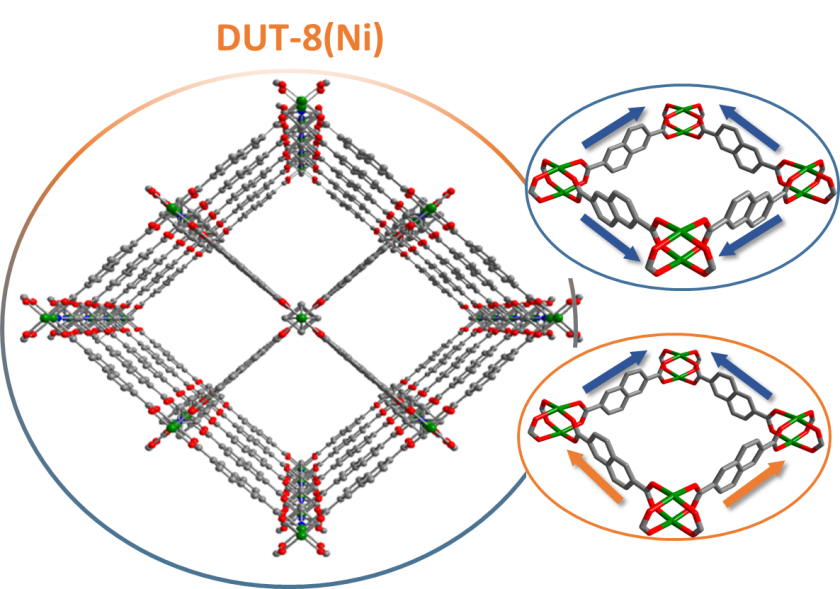BESSY II: New insights into switchable MOF structures at the MX beamlines

View into a MOF crystal exemplified by DUT-8. The massive pores are clearly discernible. © TU Dresden
Metal-organic framework compounds (MOFs) are widely used in gas storage, material separation, sensor technology or catalysis. A team led by Prof. Dr. Stefan Kaskel, TU Dresden, has now investigated a special class of these MOFs at the MX beamlines of BESSY II. These are "switchable" MOFs that can react to external stimuli. Their analysis shows how the behaviour of the material is related to transitions between ordered and disordered phases. The results have now been published in Nature Chemistry.
Metal-organic framework compounds (MOFs) consist of inorganic and organic groups and are characterised by a large number of pores into which other molecules can be incorporated. MOFs are therefore interesting for many applications, for example for the storage of gases, but also for substance separation, sensor technology or catalysis. Some of these MOF structures react to different guest molecules by changing their structures. They are thus considered switchable.
One of these is "DUT-8", a material that has now been studied at the MX beamlines of BESSY II. "MOF crystals can be analysed very well at the MX beamlines," says HZB expert Dr. Manfred Weiss, who heads the MX team. “MOF crystals have many things in common with protein crystals. For example, both are interspersed with large pores, which are filled with liquid in the protein crystals, while those in MOFs provide space for guest molecules," Weiss explains.
"The diffraction patterns that DUT-8 showed on the HZB-MX beamlines were extremely complex. We were now able to attribute this to various transitions between ordered and less ordered phases," explains Stefan Kaskel. The enclosed guest molecule directs the network into one of over a thousand possible disorder configurations. The results contribute to a better understanding of switching processes and gas exchange reactions in such MOF structures, so that future functional MOF materials can be developed in a targeted manner.
The investigations were supported by the DFG programme (FOR2433).
red.
https://www.helmholtz-berlin.de/pubbin/news_seite?nid=22861;sprache=en
- Copy link
-
Ernst Eckhard Koch Prize and Innovation Award on Synchrotron Radiation 2025
At the 27th BESSY@HZB User Meeting, the Friends of HZB honoured the dissertation of Dr Enggar Pramanto Wibowo (Friedrich-Alexander University Erlangen-Nuremberg). The Innovation Award on Synchrotron Radiation 2025 went to Prof. Tim Salditt (Georg-August-University Göttingen) and Professors Danny D. Jonigk and Maximilian Ackermann (both, University Hospital of RWTH Aachen University).
-
Bright prospects for tin perovskite solar cells
Perovskite solar cells are widely regarded as the next generation photovoltaic technology. However, they are not yet stable enough in the long term for widespread commercial use. One reason for this is migrating ions, which cause degradation of the semiconducting material over time. A team from HZB and the University of Potsdam has now investigated the ion density in four different, widely used perovskite compounds and discovered significant differences. Tin perovskite semiconductors produced with an alternative solvent had a particular low ion density — only one tenth that of lead perovskite semiconductors. This suggests that tin-based perovskites could be used to make solar cells that are not only really environmentally friendly but also very stable.
-
Synchrotron radiation sources: toolboxes for quantum technologies
Synchrotron radiation sources generate highly brilliant light pulses, ranging from infrared to hard X-rays, which can be used to gain deep insights into complex materials. An international team has now published an overview on synchrotron methods for the further development of quantum materials and technologies in the journal Advanced Functional Materials: Using concrete examples, they show how these unique tools can help to unlock the potential of quantum technologies such as quantum computing, overcome production barriers and pave the way for future breakthroughs.
